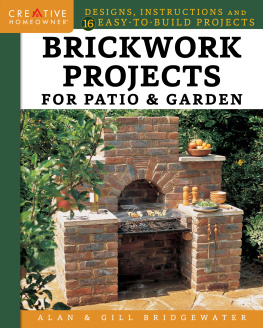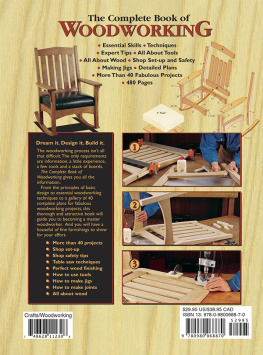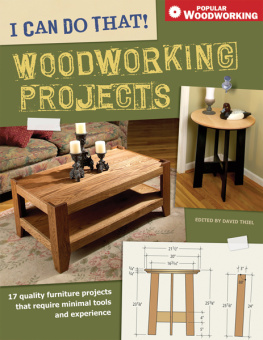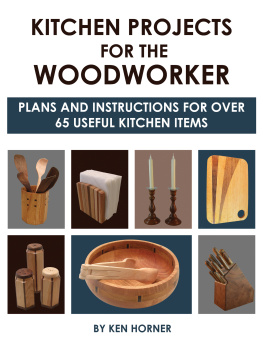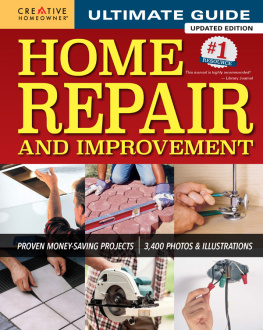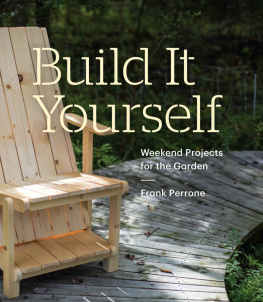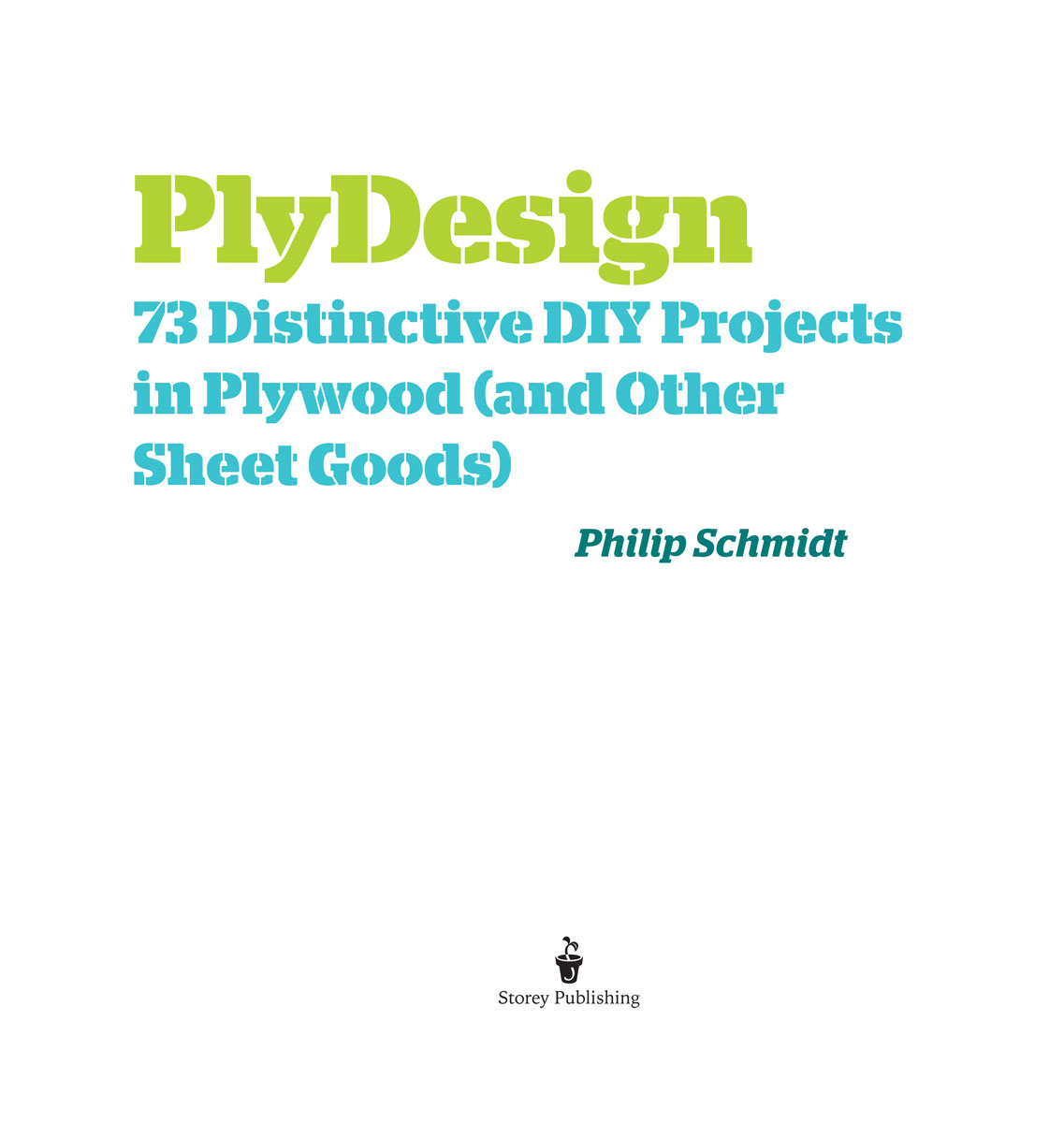I would like to dedicate this book to all of the creative people whose work fills its pages, and to my daughter, Leigh, who began her official design work at age two, building ambitious structures with dozens of baby board books. I have no doubt that the parents of every one of this books contributors have a similar story to tell.
PS
The mission of Storey Publishing is to serve our customers by publishing practical information that encourages personal independence in harmony with the environment.
Edited by Nancy Ringer and Lisa Hiley
Art direction by Alethea Morrison
Book design by MacFadden and Thorpe
Pencil renderings by Michael Gellatly
Technical drawings by Peter Sherratt
Cover photography by:
Front cover, row 1, left to right: Eric Bishoff, Alexis Liu, Chad Kelly, Lightbox Images Photography, images by Thomas Cooper, Steven Ewoldt; row 2, left to right: Arthur Koch, Lightbox Images Photography, images by Thomas Cooper, Sara Schalliol-Hodge; row 3, left to right: Maya Lee, Marcelino Vilaubi, Eric Bishoff; row 4, left to right: Adele Cuartelon, Christy Oates, Mark Bradley; row 5, left to right: Ryan Mahan, Beth Blair, Marcus Papay
Back cover; top to bottom: Cezary Gajewski, Dieter Amick, James Scheifla, Marcelino Vilaubi
Interior photography credits appear on
Indexed by Nancy D. Wood
2012 by Storey Publishing, LLC
Ebook production by Kristy L. MacWilliams
Ebook version 2.1
July 16, 2015
All rights reserved. No part of this book may be reproduced without written permission from the publisher, except by a reviewer who may quote brief passages or reproduce illustrations in a review with appropriate credits; nor may any part of this book be reproduced, stored in a retrieval system, or transmitted in any form or by any meanselectronic, mechanical, photocopying, recording, or otherwithout written permission from the publisher.
The information in this book is true and complete to the best of our knowledge. All recommendations are made without guarantee on the part of the author or Storey Publishing. The author and publisher disclaim any liability in connection with the use of this information.
Storey books are available for special premium and promotional uses and for customized editions. For further information, please call 1-800-793-9396.
Storey Publishing
210 MASS MoCA Way
North Adams, MA 01247
www.storey.com
Library of Congress Cataloging-in-Publication Data on file
Contents
Preface
Like most people, I used to think of plywood as a strictly utilitarian building material. As kids, we used it to cobble together treehouses, or wed lean a scrap of it over cinder blocks to make a bike jump. In our teenage years, we screwed thin sheets of it onto a lumber frame to make the curved faces for our skateboard ramps (which we promptly spray-painted with antiestablishment symbols; I wonder if real anarchists got in trouble for coming in late to dinner). Back then it never would have occurred to me that the finely shaped and artfully painted decks of our skateboards also were made of plywood.
Even when I worked as a carpenter I knew plywood only as subflooring, roof decking, and sides for concrete forms. And, of course, plywood is ideal for all those applications. But as this book shows, construction is just the beginning.
I can recall two discoveries that opened my eyes to the design possibilities of plywood. The first was a gallery space in Minneapolis that had every wall lined with full sheets of clear-coated maple panels. These were gapped about an inch apart and mounted with trimhead screws. Entering the room, I was entranced by the towering wood surfaces and the breadth of their luminous grained faces. And then, upon close inspection of the gaps, seeing the stratified core of the material: Plywood! Yes! Why not?
My other plywood moment was seeing one of Charles Eamess molded plywood leg splints for the first time, in a small art exhibition where I could get close enough to touch it with my nose. Modernists of all stripes know this piece as a seminal work of design, engineering, and mass-production technique, but at the time I was unfamiliar with all that, and I was completely enthralled by the work and its conception. As the story goes, Eames was told by a doctor in 1941 that the metal splints used in the battlefields of Europe were too heavy and lacked sufficient means for strapping limbs. With considerable effort and innovation, the designer created a plywood version that was strong and lightweight, had plenty of holes for strapping (thanks in part to cutouts necessary for production), and worked equally well for both right and left legs. The U.S. government ultimately bought over 1,500 of them.
Perhaps whats most remarkable about the Eames splint is its beauty. It is, in essence, a work of art in wood. And it had to be plywood; you certainly couldnt carve 1,500 splints out of solid wood blocks (especially in wartime). Today you could easily make the splints with plastics or carbon fiber, but they still wouldnt have the look and feel of real wood. Thats what makes plywood such a great and unique material. Its a precisely machined, manufactured product that started life as a tiny seed in the groundthe perfect blend of nature and engineering.
This book features the creative work of dozens of design professionals, students, and enthusiasts (and at least one full-time writer: me), all of whom share a love of plywood and what you can do with it. These projects are built with ordinary shop tools and range in difficulty from downright easy to somewhat wood-workery. Not all of the pieces are made with plywood, or with plywood alone. Some call for MDF (medium-density fiberboard), some have glass or aluminum parts, and one particularly stylish work makes decorative use of construction-grade strandboard. In every case, you can rest assured that these designers know their materials, and youll be amazed at what you can create using readily available, off-the-shelf supplies.
If youre a designer, woodworker, or experienced maker, Im sure youll be inspired and entertained by many of the fresh ideas presented in these pages. And if youre new to the shop or the drawing board, I hope this book or one of its projects becomes one of your own plywood moments.
Philip Schmidt
Chapter 1
Shop Talk
Buying, hauling, and working with sheet goods: an unhandymans guide to understanding plywood (and its woody cousins).
A Panel Discussion: All about Plywood
Plywood is the head of a growing family of wood-based panels generically referred to as sheet goods, or sheet stock. All of these fall under the category of engineered wood: building products that start out as trees and, after a good deal of industrial processing, end up as interchangeable products made to precise specifications. While solid wood has many undeniable merits, the beauty of the engineering is that it removes or counteracts some of woods biggest drawbacksnamely, knots and other natural flaws, shrinkage and expansion, and warpage, plus the fact that you cant buy a nice solid-wood board wider than 11 without refinancing your house.
HOW PLYWOOD IS MADE
Plywood gets its unique blend of strength, stability, and economy from its layered construction. A plywood panel is made up of thin plies, or veneers, of wood glued together under pressure and heat. Each ply is laid perpendicular to the plies above and below. This process, called cross-graining, is key to plywoods strength and dimensional stability. Moisture causes wood to expand and contract mostly



